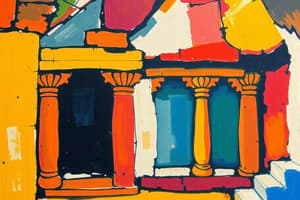Podcast
Questions and Answers
Which country is known for its printed cloth?
Which country is known for its printed cloth?
- Uzbekistan (correct)
- Turkmenistan
- Kazakhstan
- Tajikistan
What are the ancient rock drawings found throughout Kazakhstan called?
What are the ancient rock drawings found throughout Kazakhstan called?
- Petroglyphs (correct)
- Engravings
- Carvings
- Etchings
Which of the following is NOT mentioned as a craft produced by Tajiks?
Which of the following is NOT mentioned as a craft produced by Tajiks?
- Utensils
- Sculptures (correct)
- Furniture
- Fabrics
What type of carpet is Turkmenistan known for producing?
What type of carpet is Turkmenistan known for producing?
Which of the following is NOT listed as a typical artistic form from West Asia?
Which of the following is NOT listed as a typical artistic form from West Asia?
What are the Ajanta caves known for?
What are the Ajanta caves known for?
Which of the following is an important Hindu festival celebrated with lights?
Which of the following is an important Hindu festival celebrated with lights?
What is the significance of the Taj Mahal?
What is the significance of the Taj Mahal?
Which of the following is an ancient Indus Valley Civilization city?
Which of the following is an ancient Indus Valley Civilization city?
What is 'Rangoli' associated with?
What is 'Rangoli' associated with?
What is 'Truck Art' in Pakistan?
What is 'Truck Art' in Pakistan?
Flashcards are hidden until you start studying
Study Notes
Central Asian Arts and Crafts
- Uzbekistan is known for its printed cloth.
- Kazakhstan is home to ancient petroglyphs, created by nomads drawing on rocks.
- Tajikistan has a long history of producing fabrics, utensils, musical instruments, carpets, furniture, and jewelry.
Carpet-Making Traditions
- Turkmenistan is renowned for producing some of the world's most unique and beautiful carpets.
- Kyrgyz women create a wide range of textiles, primarily from the felt of their sheep, including keteni, a type of homespun silk.
Traditional Textiles
- Shirdaks are hand-made carpets or rugs.
- Tush Kyiz are large, elaborately embroidered wall hangings.
West Asian Arts and Crafts
- The region is rich in cultural heritage, reflected in its varied and high-quality arts and crafts.
- Typical artistic forms include embroidery, calligraphy, ceramics, inlaid wood designs, wood carving, blown glass work, and hammered metal work.
Indian Arts and Crafts
Ajanta Caves
- The Ajanta caves in Maharashtra, India, date back from the 2nd century BCE to the 600 CE.
- The caves feature paintings and sculptures considered masterpieces of Buddhist religious art, similar to the Sigiriya paintings in Sri Lanka.
Indian Mythology
- Shiva, the Destroyer, is often depicted as a four-armed figure.
Indian History
- The Islamic Ascendancy (1192-1757), also known as the Transitional Period, saw the evolution from Vedism to Hinduism or Brahmanism.
- This period saw the emergence of the two great Indian epics, the Mahabharata and Ramayana.
Taj Mahal
- The Taj Mahal was built in 1632 by Shah Jahan in memory of his wife, Mumtaz Mahal, who died during childbirth.
Diwali Celebrations
- Diwali, the Festival of Lights, is celebrated by Hindus in India and worldwide in October or November.
- Lakshmi is the goddess of wealth.
- Diyas are clay lamps used during Diwali celebrations.
- Rangoli is a decorative design made with colored powders or flowers, consisting of two words: 'rang' meaning 'color' and 'aavalli' meaning 'colored creepers' or 'row of colors'.
Pakistani Architecture
- Pakistani architecture can be divided into four recognized periods: Pre-Islamic, Islamic, Colonial, and Post-Colonial.
Historical Sites
- Mohenjo Daro is an ancient Indus Valley Civilization city that flourished between 2600 and 1900 BCE.
- Kot Diji Fort was built by Mir Sohrab Khan Talpur between 1785 and 1795.
Pakistani Art
- Truck Art is a unique Pakistani art form featuring brightly colored, flamboyant trucks, painted with images of idealized landscapes, famous personalities, flowers, and trees.
Studying That Suits You
Use AI to generate personalized quizzes and flashcards to suit your learning preferences.




